


When NetApp set out to design the FAS2500 series, we knew we were designing a platform for a segment of the market where budgets were often very tight and where available storage expertise was sometimes limited. With these factors in mind, our goal was to deliver a new entry platform that delivers greater value with more flexibility to simplify operations—without sacrificing advanced capabilities such as nondisruptive operations, storage efficiency, or integrated data protection.
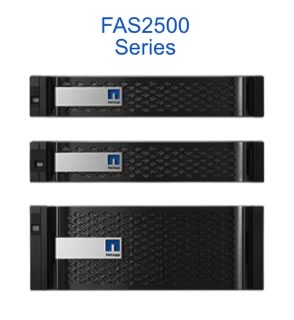 With enhanced support for clustered Data ONTAP® software and flash, the new FAS2500 is designed to facilitate growth, so you can start small and grow by scaling your storage both up and out without interrupting service.
With enhanced support for clustered Data ONTAP® software and flash, the new FAS2500 is designed to facilitate growth, so you can start small and grow by scaling your storage both up and out without interrupting service.
The FAS2500 Hybrid Storage Platform

Just because a storage requirement is modest in terms of capacity or performance doesn't mean the hardware that satisfies that requirement has to be a compromise. The FAS2500 series is an extremely capable and flexible storage platform that can be configured in all-HDD, hybrid (HDD + SSD), or all-flash configurations. This platform delivers all the enterprise capabilities of its larger FAS8000 cousins. (See the recent article on the FAS8000 series and this month's article on the new FAS8080 EX for more on that.)
We've built the FAS2500 to be much more powerful than its predecessors, with three times the memory, twice the NVRAM to accelerate write performance, and five times the flash for hybrid storage configurations to allow you to accelerate more workloads. We've also given each model massive I/O capabilities with greater flexibility for investment protection.
FAS2552 and FAS2554
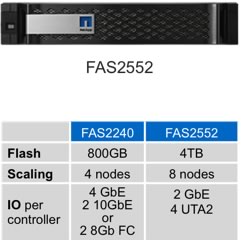 Base Systems. The FAS2552 and FAS2554 use the same controllers but are delivered in different enclosures supporting different disk types. Each enclosure can house either a single controller or dual controllers. (NetApp refers to dual controllers as an HA pair.) Dual- and single-controller configurations support up to 4TB of flash for hybrid storage. An HA pair provides 36GB of memory and 4GB of NVMEM.
Base Systems. The FAS2552 and FAS2554 use the same controllers but are delivered in different enclosures supporting different disk types. Each enclosure can house either a single controller or dual controllers. (NetApp refers to dual controllers as an HA pair.) Dual- and single-controller configurations support up to 4TB of flash for hybrid storage. An HA pair provides 36GB of memory and 4GB of NVMEM.
The FAS2552 is intended for performance-oriented workloads, while the FAS2554 is for capacity-oriented ones. The FAS2552 comes in a 2U enclosure designed to accept 2.5" small form factor (SFF) performance HDDs and a range of SSDs. The FAS2554 uses a 4U enclosure designed to accept 3.5" large form factor (LFF) capacity HDDs, and also supports 400GB SSDs, allowing for hybrid storage configurations in the base enclosure without external shelves.
External Shelves. In addition to the base enclosures, these two models can be configured with up to five external shelves of any type (for a total of 144 drives) and can support a mix of performance HDDs, capacity HDDs, and SSDs as needed. (See the FAS Disk Shelves and Storage Media Technical Specifications for more details on available external options.) With external shelves both support a maximum capacity over 500TB. (See Table 1.)
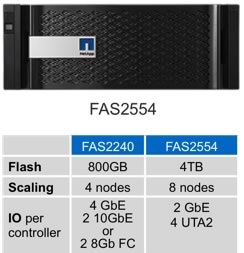 Flexible Connectivity. For client and host network connections, each FAS255x controller includes four unified target adapter 2 (UTA2) ports (8 total per HA pair), the same flexible network ports offered on the FAS8000. NetApp UTA2 ports are a storage industry first. By changing the optics and setting a software switch, these ports can be configured for 16Gb/sec Fibre Channel (FC) or 10GbE (or a combination), giving you greater flexibility now and in the future.
Flexible Connectivity. For client and host network connections, each FAS255x controller includes four unified target adapter 2 (UTA2) ports (8 total per HA pair), the same flexible network ports offered on the FAS8000. NetApp UTA2 ports are a storage industry first. By changing the optics and setting a software switch, these ports can be configured for 16Gb/sec Fibre Channel (FC) or 10GbE (or a combination), giving you greater flexibility now and in the future.
You can connect to existing FC SANs with the highest available FC bandwidth of 16Gb/sec. (The UTA2 is also capable of 8Gb/sec and 4Gb/sec FC.) If you don't have a current need for FC, you can configure the ports for 10GbE to support FCoE and iSCSI SAN connectivity and NFS and CIFS/SMB client connectivity, so you never have to leave ports sitting idle.
Easy Upgrades. If you outgrow your FAS2552 or FAS2554, you can convert your base chassis into a standard disk shelf by replacing the controller(s) with I/O modules (IOMs). Connect the converted shelf to the FAS8000 controllers of your choice, and you are back in business with no data migration required and a minimum of downtime.
FAS2520
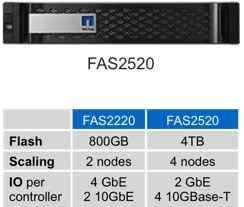 At the low end of the FAS2500 line, the FAS2520 delivers up to 12 disk drives in 2U of rack space and supports expansion up to 84 drives with a maximum of three external shelves delivering 336TB of capacity. Internal disks can include performance HDDs, capacity HDDs, and/or SSDs. This model is available in dual- and single-controller configurations that support up to 4TB of flash for hybrid storage. An HA pair provides 36GB of memory with 4GB of NVMEM.
At the low end of the FAS2500 line, the FAS2520 delivers up to 12 disk drives in 2U of rack space and supports expansion up to 84 drives with a maximum of three external shelves delivering 336TB of capacity. Internal disks can include performance HDDs, capacity HDDs, and/or SSDs. This model is available in dual- and single-controller configurations that support up to 4TB of flash for hybrid storage. An HA pair provides 36GB of memory with 4GB of NVMEM.
10GBase-T Connectivity. Instead of the UTA2 ports offered in the FAS255x and FAS8000, the FAS2520 provides four 10GBase-T ports per controller (eight per HA pair). This not only decreases FAS2520 hardware costs, it also decreases the cost of associated cabling (you can use off-the-shelf CAT6e cabling) and other network gear and simplifies network configuration overall—while still delivering an incredible amount of raw network bandwidth. These ports provide iSCSI SAN connectivity plus NFS and CIFS client connections, and autorange to GbE speed when needed. FC and FCoE protocols are not supported on the FAS2520, as they are rarely used with storage of this class.
Table 1) Comparison of FAS2500 models. (Numbers shown are per HA Pair.)
| FAS2552 | FAS2554 | FAS2520 | |
| Maximum capacity | 518TB | 576TB | 336TB |
| Maximum disk drives | 24 Internal (SFF) 144 Total | 24 Internal (LFF) 144 Total | 12 Internal (LFF) 84 Total |
| Controller form factor | Single-enclosure HA: 2 controllers in 2U | Single-enclosure HA: 2 controllers in 4U | Single-enclosure HA: 2 controllers in 2U |
| Memory | 36GB | 36GB | 36GB |
| Max hybrid flash (VST) | 4TB | 4TB | 4TB |
| NVRAM | 4GB | 4GB | 4GB |
| On-board I/O: 10GBase-T | NA | NA | 8 |
| On-board I/O: UTA2 (10GbE/16Gb FC) | 8 | 8 | NA |
| On-board I/O: GbE | 4 | 4 | 4 |
| On-board I/O: 6Gb SAS | 4 | 4 | 4 |
| OS Version | Data ONTAP 8.2.2 | ||
Reliability and Availability
To achieve superior reliability and availability we've equipped the FAS2500 with features usually only found on much more expensive storage systems. For instance, it uses the same service processor design as the FAS8000 series. The service processor remains operational even when a storage system is down and provides capabilities such as remote power cycle, call-home notification, and always-on access for troubleshooting.
For out-of-band management of SAS disk shelves, the FAS2500 includes Alternate Control Path (ACP) technology. ACP gives a storage controller the ability to reset a storage channel without communicating over that channel. If a channel is down or misbehaving, a quick reset can bring it back online without external intervention. ACP allows a storage system to recover from faults that might otherwise require it to reboot, and that's a big advantage.
When you consider all the great hardware reliability features of the FAS2500, including dual controllers, system-level diagnostics, and multipath HA (MP-HA), in combination with hardware designs that have been extensively tested and verified to deliver availability in excess of 99.999%, plus the proven nondisruptive operations capabilities of clustered Data ONTAP, it's pretty clear that this is a platform that won't let you—or your business—down.
Flexible Flash Architecture: Performance Where You Need It

As I said earlier, the FAS2500 series has a very flexible architecture capable of supporting media configurations including all-flash, hybrid, and all-HDD deployments. I believe that for this platform, hybrid configurations combining either performance or capacity HDDs and SSDs are the sweet spot. Hybrid configurations using our virtual storage tier (VST) technology have been shown to accelerate workloads by up to 46% and increase usable capacity by 48%. This is achieved by replacing performance HDDs alone with a combination of high-capacity HDDs and SSDs.
NetApp VST technology is designed to use flash very efficiently, and actually benefits from the use of complementary technologies such as deduplication and cloning, so you get more acceleration from a smaller investment in flash. With support for up to 4TB of flash in hybrid VST configurations on all FAS2500 systems, you can accelerate many workloads, all sharing the same storage. Storage QoS can be used to make sure that no single workload hogs too many resources.
While VST deployment is certainly the most common type of hybrid deployment expected for the FAS2500, you also have the option of deploying a mix of SSDs and HDDs, using SSDs for performance-sensitive workloads and HDDs for capacity-oriented workloads.
Designed to Scale Out

While the expanded flash architecture of the FAS2500 series delivers substantial performance benefits, we've also optimized the platform for clustered Data ONTAP to allow it to scale out to achieve greater capacity and performance. As you've already seen, you can scale up any FAS2500 model by adding HDDs for capacity and SSDs for performance.
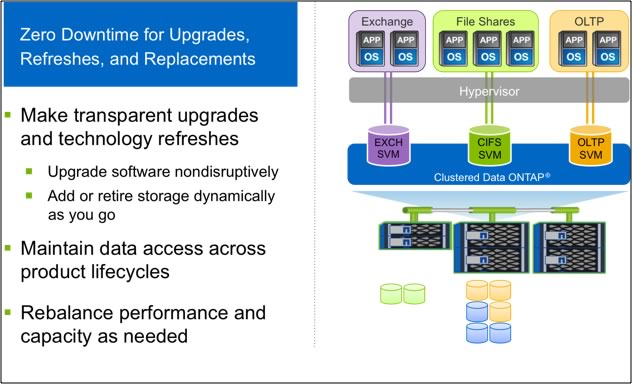
Figure 1) FAS2500 series scale-out capabilities expand performance and capacity while eliminating downtime.
When you reach the limits of scale-up in a single system, you can then scale out by adding additional controllers (nodes). With expanded scale-out capabilities (4 nodes for the FAS2520 and 8 nodes for the FAS255x) you can build out a storage infrastructure with up to 2.3 petabytes of total capacity. You can mix different types of media in your cluster to satisfy a variety of storage requirements and, when needed, you can transition from FAS2500 controllers to FAS8000 controllers for even greater performance and capacity—all without disrupting ongoing operations.
Simplified Installation and Management

While designing great hardware is important, NetApp has paid equal attention to software for the FAS2500 (and the entire FAS product line). Our wizard-driven System Setup software makes it possible to configure a FAS2500 system in 10 minutes or less. You can unbox a FAS2500 system, set it up physically including racking and cabling, configure the software, and be serving data in less than 30 minutes with no storage expertise required, and with everything done according to best practices.

Figure 2) System Setup software makes it possible to get a FAS2500 system up and running with no storage expertise required.
Similarly, our suite of OnCommand® management tools including OnCommand System Manager and OnCommand Workflow Automation simplify management and allow you to automate routine processes.
Finally, when it comes to storage, it just makes sense to choose infrastructure that offers complete integration for enterprise applications such as Oracle® Database, SAP®, and Microsoft® Exchange, SQL Server, and SharePoint. Integration facilitates deployment, management, and protection of important applications.
NetApp is widely regarded as an industry leader in the area of integration, providing API integration across the broadest set of technology partners, platforms, applications, and tools. We have more points of integration than any other storage vendor. This helps you to reduce IT complexity and increase availability, further accelerating the speed of business.
Cloud Connected

Ability to connect to the cloud to support backup, disaster recovery, and other functions is certainly appealing to everyone, and may be particularly desirable for smaller organizations that often don’t have or would prefer not to have a second facility for remote backup or DR.
Over 350 cloud service providers (CSPs) use NetApp FAS storage, and we’re forging relationships with hyperscale providers like Amazon Web Services. Utilizing the FAS2500 and Data ONTAP, you can choose a service provider and move data easily between your facility and the cloud using proven NetApp replication technologies to take full advantage of cloud resources.
Conclusion

The FAS2500 series is an ideal storage choice for almost any situation where there's a more modest storage requirement. Smaller shops will appreciate the FAS2500 for its easy setup, ease of use, flexibility, and consistent, flash-accelerated performance for both SAN and NAS workloads. Larger enterprises will benefit for many of the same reasons. Full feature compatibility with its larger FAS cousins and easy cloud connectivity make any of the FAS2500 models an easy choice for smaller storage requirements like remote and branch offices that need to be backed up to a central location or the cloud.





